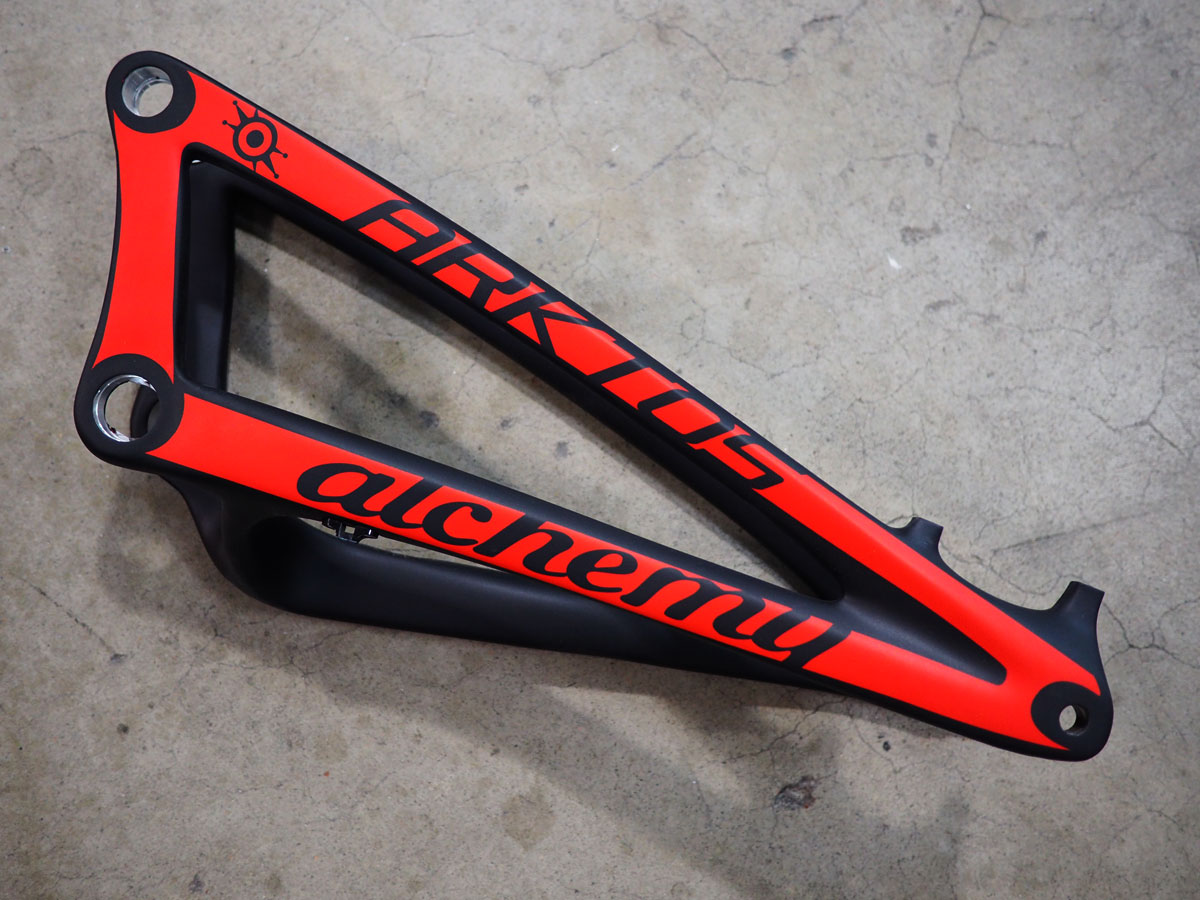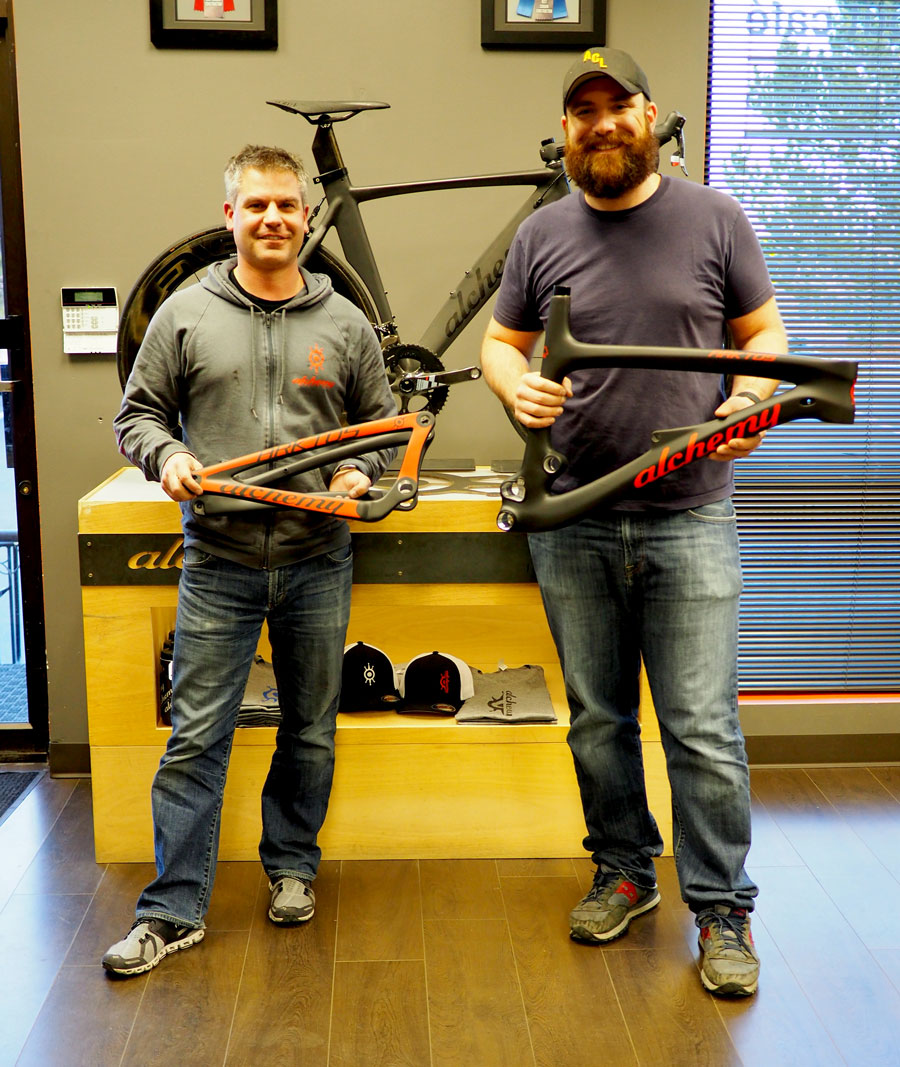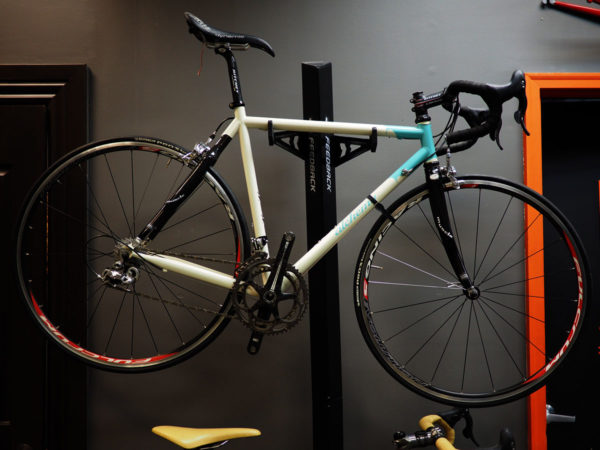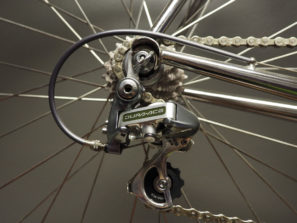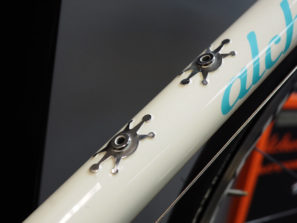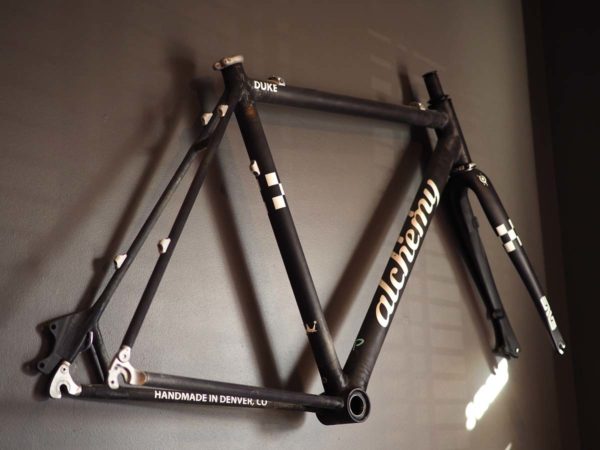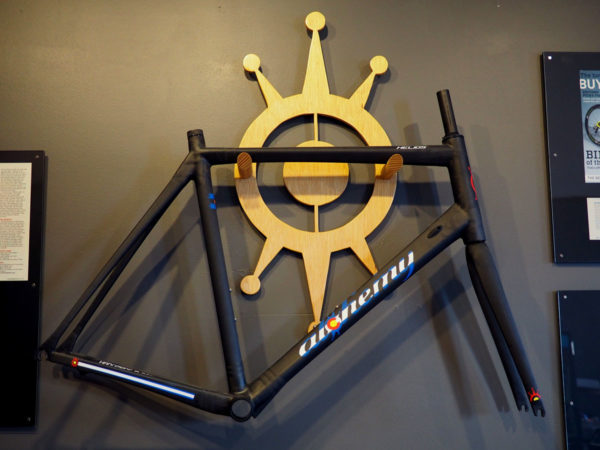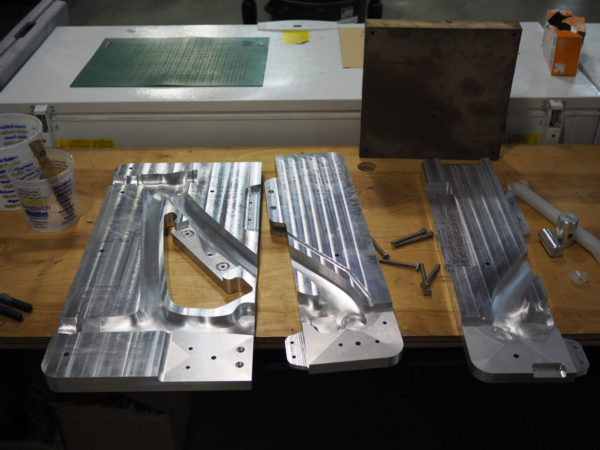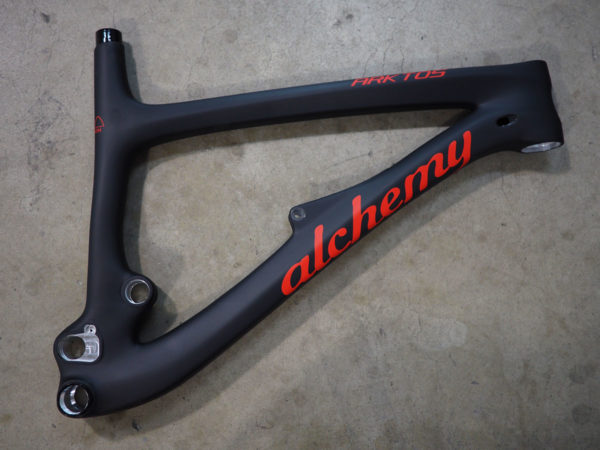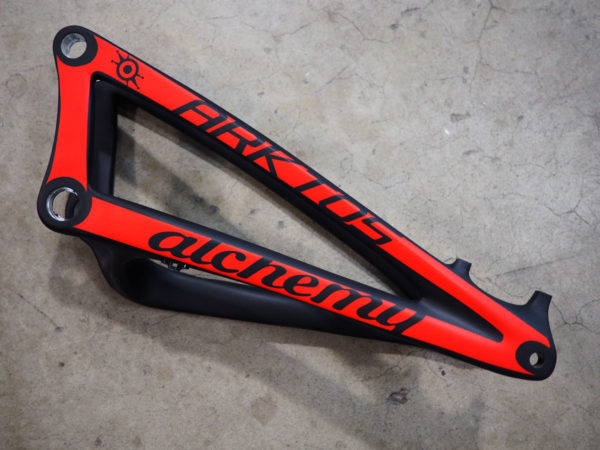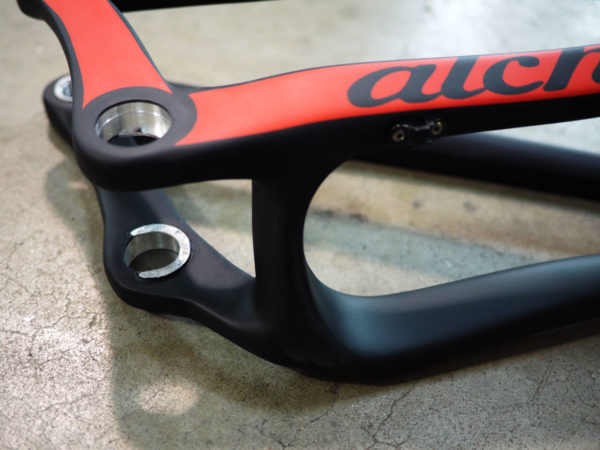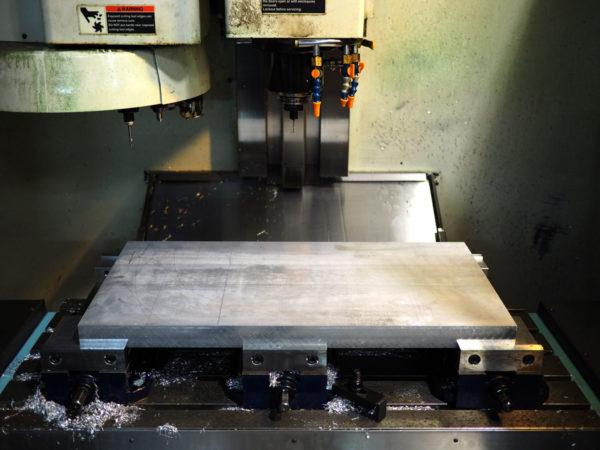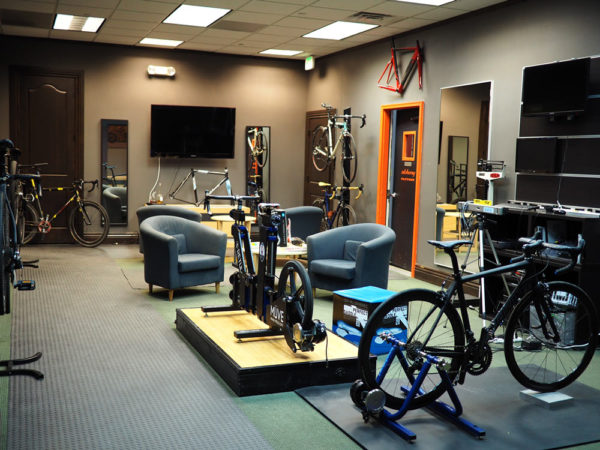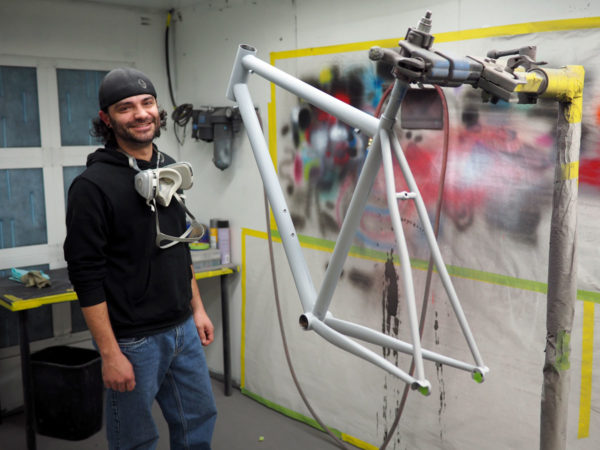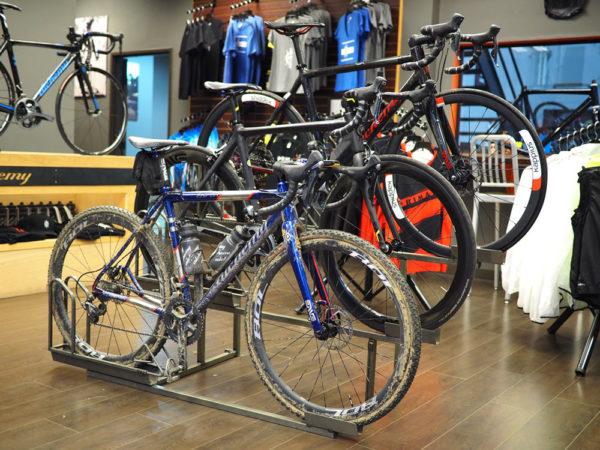In a world where almost all production carbon fiber is made overseas, Alchemy Bicycles has soldiered forth not only producing frames, but really leveraging their Denver, Colorado facility and many decades of in-house carbon manufacturing experience to push the envelope of what can be done in the medium.
The Arktos, their latest creation, is the culmination of years of intensive in-house development, allowed the company to really flex their capabilities for everyone watching in the community. Alchemy claims, after all, that the Arktos is the first domestically manufactured, production, full suspension, carbon fiber frame.
The story of the Arktos is really the story of Alchemy to this point. In order to understand more about the Arktos, we sat down with Alchemy founder, Ryan Cannizzaro, and brand product development designer/engineer, Matthew Maczuzak, at their impressive south Denver facility to understand how a brand that started in steel and titanium only eight years ago could evolve so quickly…
BIKERUMOR: How did you guys get together and decide to do something like this? This is ambitious!
RYAN: So, I actually started the company at the end of the 2008. Matt came on board in 2009, maybe?
MATTHEW: It was almost a year or just about.
RYAN: We just started doing it in steel and titanium. It was just me and a welder at that time. We wanted to do carbon fiber, but we didn’t want to go to Asia for it, and someone had introduced me and Matt, just saying “hey.” He was building some frames in Austin as well. We were in Austin, and we just kind of teamed up, started talking about what our plans and ideas and goals were for building bikes and they seemed to align. We just kind of took it from there and really built the carbon side.
The carbon was game changing because there’s really nobody else that does what we do in the United States. That helped us build our business quite a bit. At the same time, titanium has grown quite a bit as well. Steel- we took the steel out of our product line for years. But we brought it back.
BIKERUMOR: What are your volumes per category?
MATTHEW: Carbon is still the majority of what we make.
RYAN: About 80% carbon. This year might be a little bit different. We redesigned the two Ti frames – the Eros and the Chiron cross bike. That really made a lot of traction over the past year. One is because of the ride quality. Especially with all the changes in the Ti market with Serotta going out of business, things like that, everybody’s asking us to actually design a titanium frame the same we do carbon frames, not just buy off the shelf headtubes, dropouts, and things like that – build something that somebody else is building just down the street. It also has to have a ride quality and design features as the Alchemy carbon, is what we were being told. So we looked at things like what we could do with the head tube and the dropouts, change up the diameter of tubing. Matt was able to really design a Ti frame that rides a lot like our Helios carbon frame, which has gotten a ton of traction in the past year.
BIKERUMOR: What are the numbers going through the facility? It’s big. It’s really big. But I’ve only seen, like, four people here.
RYAN: As far as employees… one, two, three, four… I think nine including me and Matt. Because we are going so quickly, at this point this year, I think we’re about at 200 [frames] and that’s with the full release of the Arktos.
BIKERUMOR: Matt, you were hanging out in Austin – what was your composite experience before joining Alchemy?
MATTHEW: Really, my background was more injection molding, consumer and medical product development. I worked for a firm in Cleveland for a lot of years. Industrial design firm.
BIKERUMOR: I feel like a lot of high design is infiltrating the bike industry, lately.
MATTHEW: Kind of working its way in, yeah. I think that [experience] worked out really well for what we’re doing because for a decade I worked on both sides of the coin. I was, you know, engineer for tooling and manufacturing so I had the understanding, but I also did a lot of design development too. I happened to be the right age and the right time that when I came into the firm, 3D CAD was just taking off as a design tool.
BIKERUMOR: You were just through school, knew it from school.
MATTHEW: Yeah. So I got into cycling at some point in my career and then I got a nice fancy bike, a carbon bike, and I broke it. I had some issues beyond that, and I just kinda got the idea, “I wonder if I could make one.” So I called up ENVE on a whim and talked to Carl, who is a good friend now over there, and just started making frames in my backyard and kind of went from there.
BIKERUMOR: And then you get a call from a guy who wants to start doing production carbon – and you weren’t intimidated by that?
MATTHEW: No.
RYAN: It was more about – we were kind of set up to make the, I would say, investment in the resources that Matt needed to build ‘em bigger, build ‘em faster and, I would say, at a higher quality.
MATTHEW: Much better, I would say. I was just using round tubes, you know. The synergy kind of made it so we could design our own molds.
BIKERUMOR: You guys were building with ENVE for a while, then. When did you switch over to your own stuff?
MATTHEW: We designed the molds, but ENVE was making the tubes for us originally. But then, I guess it was three years ago?
RYAN: Yeah. 2012.
BIKERUMOR: I remember that. Your momentum at that point was crazy. Everyone wouldn’t stop talking about what you guys were developing. It was really exciting.
MATTHEW: I’m glad that people outside of our bubble…
BIKERUMOR: You don’t stick your heads up that often do you?
MATTHEW: No.
BIKERUMOR: Can we talk about the Arktos? How did that come about? And beyond that, who gets to say, “Hey, I got this idea for a bike?”
MATTHEW: I think that we, from day one, always try to expand through what we’re doing and make our line-up more robust. We started primarily with just road and then, from there, went on to cyclocross and then gravel. We’re always trying to go beyond and do more and kind of push the envelope as far as what can be made in the States. We’ve always flirted with the idea. We’ve always done Ti mountain bikes. We’ve done steel too. We really, to be completely honest, finally developed the technologies we needed in house. We invested in technologies that we needed to do something more than just tube-to-tube construction.
We started with the hardtail and kind of wrapped our heads around it and went from there. Just as a matter of luck, somewhat, through a mutual friend, we started talking to David Earle, he did the original Yeti Switch, I mean he had this set of patents for this third generation suspension system he wanted to do, and he wanted to work with a smaller USA-based company. He was kind of disenchanted with the idea of working with a big conglomerate company who would take his ideas and run away. He wanted to be involved. We were extremely happy to do that. From there on, with his linkage, he and I got together and designed the rest of the frame around that. We went from there.
BIKERUMOR: So you guys wanted to do suspension. He had a linkage. And he wanted to work with this kind of operation. It’s not an OE thing. It’s an Alchemy.
MATTHEW: It is an Alchemy bike. You saw the mold over there.
BIKERUMOR: That’s really cool. I’m really stoked by that. Do you use aluminum for all your carbon molds?
MATTHEW: I do. It’s easy to get through the machine. With the volume that we’ve been doing, I mean with this Arktos -if it becomes a routine- I’ll pull the trigger on either hard ano-ing some aluminum molds or building some steel molds to extend the cycle life to 200 parts or so.
BIKERUMOR: That’s appropriate. That’s scrappy.
MATTHEW: I guess that’s really the story. You know, small company trying to compete. We do everything we can to do it on a budget of a small domestic company.
BIKERUMOR: So it’s full suspension carbon, with a carbon rear. Have you attempted full suspension in anything else you’ve done? Or is this the first?
MATTHEW: This is the first one. We flirted with the idea in the past. Like anybody else, we got our hands on some Ventana rear ends and thought, you know, we’ll make some bikes out of these. But it was never realized what we thought the Alchemy brand was and what we expect from our products.
BIKERUMOR: Speak a little bit more to that. Is that just using someone else’s rear end? Why isn’t that Alchemy?
RYAN: We’re constantly thinking about how we can make it different in this industry, and I think that’s what Matt and I always talk about. We’re going to do it, we’re just not going to make a product that’s already been out there and been done. We want to make a product we feel is better and will actually make a difference throughout the industry. We were also looking at doing a TT frame at the same time. Talking to people around the industry and outside the industry and just trying to figure out if that’s a path we can go down. It just so happened that mountain bike… we started talking to David Earle and it started leaning. We can actually do something a little bit different that we think the industry would benefit from. And doing a full suspension all carbon fiber mountain bike in the United States is unheard of.
MATTHEW: We think it’s the only domestically made carbon suspension bike.
RYAN: And the other thing was being able to work with David and have the exclusive rights to this suspension system, which is absolutely amazingly awesome. Being able to bring that to market and put that in people’s hands is amazing for us.
BIKERUMOR: What I think is interesting about this project is having a full suspension carbon domestically produced bike by itself adds to the dialogue, but it seems like the Arktos so far beyond just “adding to the dialogue.” The full suspension project seems above and beyond just contributing.
Is that how you choose your projects now? Are you over just being able to make carbon bikes here, and now what you make has to be crazy? What is the threshold for something being chosen for one of your projects at this time?
MATTHEW: I guess I’m just speaking for myself, I like turning over rocks, you know? Trudging through fresh snow. That’s what excites me, is pushing the envelope and seeing what we can do. We are confident enough with the guys out there and all the supporting people around us that we can make a product that can not only perform well but be a technological advancement. I think we agree, we had that conversation when we first got into this, realizing that we probably made a lot of steps in order to produce this frame, at least from a public perception point of view. I don’t think that a lot of people know what we’re capable of back here.
BIKERUMOR: I don’t think so either. It’s really cool.
RYAN: I mean, you look at something like the Arktos , it’s just the beginning of a whole new way of looking at the market for Alchemy. Like Matt said earlier, could we have made an Artos three years ago? Probably not. There’s been a lot of development that has led up to this. Now we’re able to do this, now where are we able to go? What does that look like? We’ll find out I guess. A lot of stuff that went into the Arktos was because of what we learned on the road side like lay ups and lay up schedules. All that stuff has to be figured out. And then just the molding process. With different models, every time Matt has kind of upgraded the whole process which has taken us to the point where we can do something like the Arktos. Then, what can we do next?
BIKERUMOR: How do you test your product? Do you have testing facilities hanging out here?
MATTHEW: We outsource it. But we test ride everything. I’m a big guy.
RYAN: We get all of them passed to ISO 2014 testing. They run them past that. Depending on what model we’re designing, there is a percentage we test.
BIKERUMOR: That’s something that I think sounds really bad, but I don’t think people fully understand that it is a pro situation where you really are testing, that you’re really holding yourself to these high standards.
RYAN: It’s funny you say that because a lot of people -we get calls from people all around mostly the U.S. but also outside the US- that say “Well, I’m going to be out there, I want to come see your facility before I buy a bike.” Something like that, because they don’t necessarily know. But you walk through the doors… oh shit, this is actually an operation. These people are actually doing this stuff. These people are actually making their own molds. They’re actually making all their molds here. They’re holding themselves to the same standards of testing, if not more. I’m sure that there are people out there that probably have never even tested a frame.
BIKERUMOR: Yeah. There’s a perception of the domestic market that there is a pass for that stuff, which is ludicrous.
MATTHEW: Yeah, it screws it up.
RYAN: I think it is a little bit different when you’re dealing with carbon fiber too versus steel or even titanium. You know, steel frames, if you’re holding yourself, I guess, to the welding, then you know you’re using a tubeset that has hopefully been tested by the manufacturer of the tubeset. So maybe that’s why people have kind of been able to get away with it. But for us, we want to know if the lay-up of a particular frame, how does that hold up? We’re not going to put someone on the Arktos unless we know they aren’t going to break it. Pushing the limits on our side and designing and manufacturing and stuff like that goes with it.
MATTHEW: A great example, the Helios is our main frame. A 56 [cm] comes in at 900 [grams], so it’s competitive but not ultra light. It rides exactly the way we want it to. We built one that was sub 700 [grams] and sent it out for testing. It passed everything with flying colors, but it rode terrible. There is a price you pay for that weight and it’s higher modulus fibers. We’re trying to make sure we can be technologically with everybody else in America, but we’re going to do it our own way.
BIKERUMOR: How do you determine what that ride quality is?
RYAN: We ride them.
BIKERUMOR: Oh okay. Thanks buddy. What’s the recipe? Is it trial and error?
RYAN: Maybe a little bit at the beginning, but Matt has gotten to the point where he understands enough about the designing of a frame he can pretty much dial it in before the bike is built and ridden.
MATTHEW: Nowadays, you learn the tricks.
RYAN: With the Aros just incorporating what you know in dropout design. You know versus wall thickness in the titanium, what s-bend stays we use versus non s-bend stays. Things like that. If you think about it and design it not using off the shelf products, you can design a fantastic bike.
MATTHEW: You apply the theoretical and you make some stuff and it’s really… you could run FEA on fiber orientation, stuff like that, but the software we have access to is not necessarily the best.
BIKERUMOR: I can hear my computer exploding from here.
MATTHEW: Right, exactly. With fiber orientation, it’s really difficult but that’s why you build them and do some empirical testing. You see how it rides. You send it off to a lab. Things like that. And then you move from there. I would say that the lion’s share of what goes into how the bikes ride is trial and error and experience.
BIKERUMOR: That means that you guys have been doing things pretty hard core in house since… 2012?
MATTHEW: In house, yeah, but even before then when we were working with ENVE with tubing and fiber orientation.
BIKERUMOR: It just goes so much faster when you’re doing it in house.
MATTHEW: Absolutely. Absolutely. But I’d say a good seven years of knowledge goes into the lay-up and design.
BIKERUMOR: I feel like there is an opportunity for you guys to do OE production here. Is that something you’re doing or have done?
RYAN: We do some for other builders, but in titanium and carbon fiber.
BIKERUMOR: But nothing massive volume.
RYAN: Smaller builders that either don’t want to build their own bikes anymore or don’t know how to build their own bikes. Some builders, I would say, might not deal with a certain material but either they’ve been making steel and they want ti, or carbon for that matter.
BIKERUMOR: Probably not making molds for those guys though.
RYAN: Mainly it’s just tubes. I would say that if you look closely at some of the stuff you’ve seen before, you would notice that you know that rear or downtube or something.
BIKERUMOR: As a couple here -you are a couple at this point because you’ve worked together for years pushing the boundaries together- are you concerned that you’re going to run out of rocks that are exciting to turn over? Or do you already know what the next rock is? You don’t have to say what it is. The Arktos is a huge leap. Are you only looking for big leaps now?
RYAN: We don’t know where the Arktos even goes. We were talking about… I don’t want to say where we’re going or what we’re doing because people might expect it. But I think it’s safe to say that getting into the mountain side, where we haven’t been, really just opens up the doors to all sorts of new things. We’ll definitely continue to grow the company in that direction as well as road and cross. And gravel! We’ll see what happens to the whole gravel scene. I think we keep an eye on stuff and we’re constantly talking about where the market is going to be in two years, five years, and ten years. You have to keep a close eye on it and see if there is opportunity for us. But again, it isn’t like we’re going to come out with a fat bike because everyone is doing fat bikes. We can’t do a fat bike better. So why go and do it? You look at a lot of other builders out there and it’s just like, wow, they are doing such fantastic jobs, either at a really low cost low end, you can’t compete there. You can’t compete with, for example, what Black Sheep in Fort Collins is doing. He does amazing stuff. So it’s like, how much change and what can we do differently?
BIKERUMOR: So you’re not doing titanium cruiser-style fat bikes any time soon?
MATTHEW: There are people doing that just fine.
BIKERUMOR: “I don’t want to invest in the tube bending equipment,” is what I’m hearing.
RYAN: (laughs) That is exactly it.
BIKERUMOR: It sounds like everything is still really exciting for you guys.
MATTHEW: Oh yeah. It always will be. If it’s not, then I need to go sit on a beach and drink mimosas or something like that.
BIKERUMOR: You should be doing that from time to time anyway. I hope you get out often, not just to get out to trade shows. So it’s still a very “hands on deck” situation for you guys?
RYAN: It is, but every single person back there has experience beyond Alchemy besides one guy we hired from a couple years ago who is kind working his way up the build process. They all have experience outside of our company building bikes. Three of them come from Serotta. We have a guy from IF. There is a brazer who has had his own company on the side.
BIKERUMOR: So the collapse of the previous American established cycling infrastructure has been good for you, then?
MATTHEW: We “consolidated” it.
RYAN: Living in Colorado has had a lot to do with it. Two of the guys that came from Serotta came before Serotta closed. It didn’t necessarily have anything to do with Serotta. Same with IF, like “I just have to get out of this weather. You guys are in Colorado. Riding is great.” People come out because they want to live here. Colorado has been really nice for us in that way.
BIKERUMOR: As far as manufacturing infrastructure, what does that look like here for the scale you’re dealing in?
RYAN: We’ve tried to bring as much stuff in house as much as possible. So when we start to have challenges with something is usually when we just start doing it ourselves. We learned early. That’s why we brought paint in house. All the tube production in house. A bunch of the Ti machining because we learned early on that relying on other people in this industry in the supply chain, especially when you’re producing at higher quantities, can really hurt you.
MATTHEW: Your vendors don’t necessarily grow at the same speed you do.
BIKERUMOR: Or you’re dealing with vendor who also deal with the defense industry, and you’re just really low on the priority list, right?
MATTHEW: Very much.
BIKERUMOR: What’s more exciting to you, developing the process, or developing the actual bike? Because it sounds like you’re pushing both of those forward at the same time.
MATTHEW: Right. The product development is my passion. Developing technologies. I think with that, there’s also the passion of really wanting to get these products out there and getting them in people’s hands and seeing them on the road.
RYAN: I would say that I drive more of the process.
MATTHEW: Yeah, for sure. I think that that’s the side you enjoy more is getting the process off the ground.
BIKERUMOR: You guys get to ride ever, or what?
MATTHEW: I have a lot of bikes…
BIKERUMOR: Yeah, but…
MATTHEW: It just so happens that prototypes 001 and 002 always end up roughly our size.
RYAN: We haven’t been for the past month or so.
MATTHEW: It’s cyclical with the seasons.
BIKERUMOR: Big rush pre-NAHBS. Then after NAHBS you sit back, have a beer. “Alright, I guess we can go do that thing, the reason why we’re here.”
RYAN: There’s definitely a lunch ride going out of here more times than not. And we ride on the weekends all the time.
MATTHEW: We get to see the sun every once in awhile.
BIKERUMOR: Who are you guys paying attention to? Who are you zeroing in on? Are you looking at the big companies as a domestically-made alternative? Are you looking at the domestic builders? Do you challenge Ben from Argonaut to break-dancing contests?
MATTHEW: No. We always do staring contests.
RYAN: Really, we’re more focused on the bigger picture.
BIKERUMOR: I feel like you guys could close the door and not worry about what anyone else is doing and be cool – just enjoy yourselves, you know?
MATTHEW: Within the community, I don’t think there is a single small builder that we would consider competition. We are all niche companies that do what we do really well. We’re really good friends with the guys at Mosiac. We’re really good friends with Nick Crumpton. We’re really good friends with Ben [Farver at Argonaut].
BIKERUMOR: You can’t not be friends with Nick Crumpton. The guy is awesome.
MATTHEW: And he helped a lot really early on. We were both in Austin together. We talk all the time. We hung out at NAHBS. I always pick up the phone for him and vice versa.
RYAN: You have to keep your eye on the bigger companies too. We have to watch a Santa Cruz, right? We just got rights to a full suspension system. If they come out with something tomorrow, what does that mean for us? Right? You have to watch the whole big picture. NAHBS is a great show where you can walk around and see what, say, Shimano is doing now. A lot of times NAHBS will bring stuff to the market faster. You have to watch that and figure out how the market is going to adapt and the big picture.
BIKERUMOR: I think it’s really interesting how the big component companies, for how OE focused they are, are, are really reliant on the smaller builder community because no one is going to adopt it faster.
RYAN: We’ll figure that out, right? And we’ve done it too. Like disc brakes on a carbon bike. Us being able to adapt disc brakes on a carbon bike- we were able to do it faster than the bigger companies. People were approaching us at NAHBS to do it.
BIKERUMOR: You ever get something crazy in your head and go “I’m going to make some carbon ninja stars.”
MATTHEW: We’ve got some carbon pint glasses running around here. With that CNC, we don’t have a ton of time for that stuff…
BIKERUMOR: You can’t tie up machines with that stuff.
MATTHEW: No. But of course find some time for some dumb stuff, because that makes it fun as well.
RYAN: You can also look at the cages. “I want to try this technique.” So you try it on something smaller.
MATTHEW: That’s a good example. Two or three years ago, I liked the idea of using the natural thermal expansion of silicone to make things. That’s where the bottle cage we make was born out of. It’s a complex shape. It requires compaction, holding a fine internal tolerance.
BIKERUMOR: I asked because I noticed you have a carbon ring.
RYAN: We make titanium rings too.
(Editor’s note: Check out our Alchemy factory tour for an inside look at how they make their frames.)
